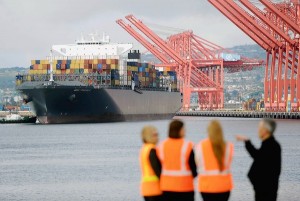By Robbin Laird
There are several new elements of the evolving global maritime transportation system, which place increasing demand on the providers of maritime security. Among those dynamics are:
- Deeper offshore drilling (such as the Arctic),
- Very large cruise ships (which are tax the ability to provide safety and security), Mega tankers,
- Widening of canals to enable greater volume and size of cargo ships, and the emergence of the mega cargo ship.
And as Hans Tino Hansen of Risk Intelligence has underscored; The FABIOLA is a miniput compared to the new triple E class from Maersk (18000 TEU containers).
http://www.worldslargestship.com/
(For the flagship publication of Risk Intelligence see https://www.sldinfo.com/products/december-2011-2/)
In a time when Washington is cutting back USCG and related activities, these challenges simply grow the gap between need and capability. Washington may be in a downward cycle in support for maritime security assets; but the demand is going the opposite way.

A recent LA Times piece reminded us of the emergence of the mega-cargo ships arrival on the scene.
The largest cargo container ship to ever dock in the Americas made a fog-shrouded first voyage into the Port of Long Beach on Friday morning, sending a message to competitors that Southern California can handle the giant vessels most others can’t welcome for at least two more years.
Out by the breakwater, it looked as though a man-made island had sprung up overnight, but the dark shape was a vessel called the Fabiola, gliding very slowly toward port.
The Fabiola is one of a new generation of vessels that can carry 11,000 or more containers, favored by ocean cargo lines because packing more freight boxes onto each ship lowers costs.
“She’s way beyond our previous record for size,” said Dick McKenna, executive director of the Marine Exchange of Southern California, which logs the arrival and departure of all ships calling at the ports of Los Angeles and Long Beach, the nation’s largest seaport complex. “This is quite a significant jump for us.”
The Fabiola, owned by Geneva-based Mediterranean Shipping Co., can carry 12,500 containers. The ship is just 30 feet shorter than the Empire State Building is tall, as wide as a 10-lane freeway and big enough to carry the contents of eight 1-million-square-foot warehouses.
http://www.latimes.com/business/la-fi-big-ship-20120317,0,3972429,print.story
When Admiral Johnson was the USCG commander in the Pacific, he and his staff were already anticipating the challenge of dealing with the very large ships and ensuring they could be examined for threats long before they entered US ports. The idea was to board the ships at sea and do the inspections at sea. Of course, this requires Cutters of various sorts to do this as the ships operate on the “Great Circle Route.” Reduced Cutter presence, no real possibility to do the boardings at sea prior to these mammouth ships being examined in ports, where it may simply be too late to eliminate the threats which very large container ships can provide.
For a look at this and other aspects for shaping a Pacific security strategy please see

